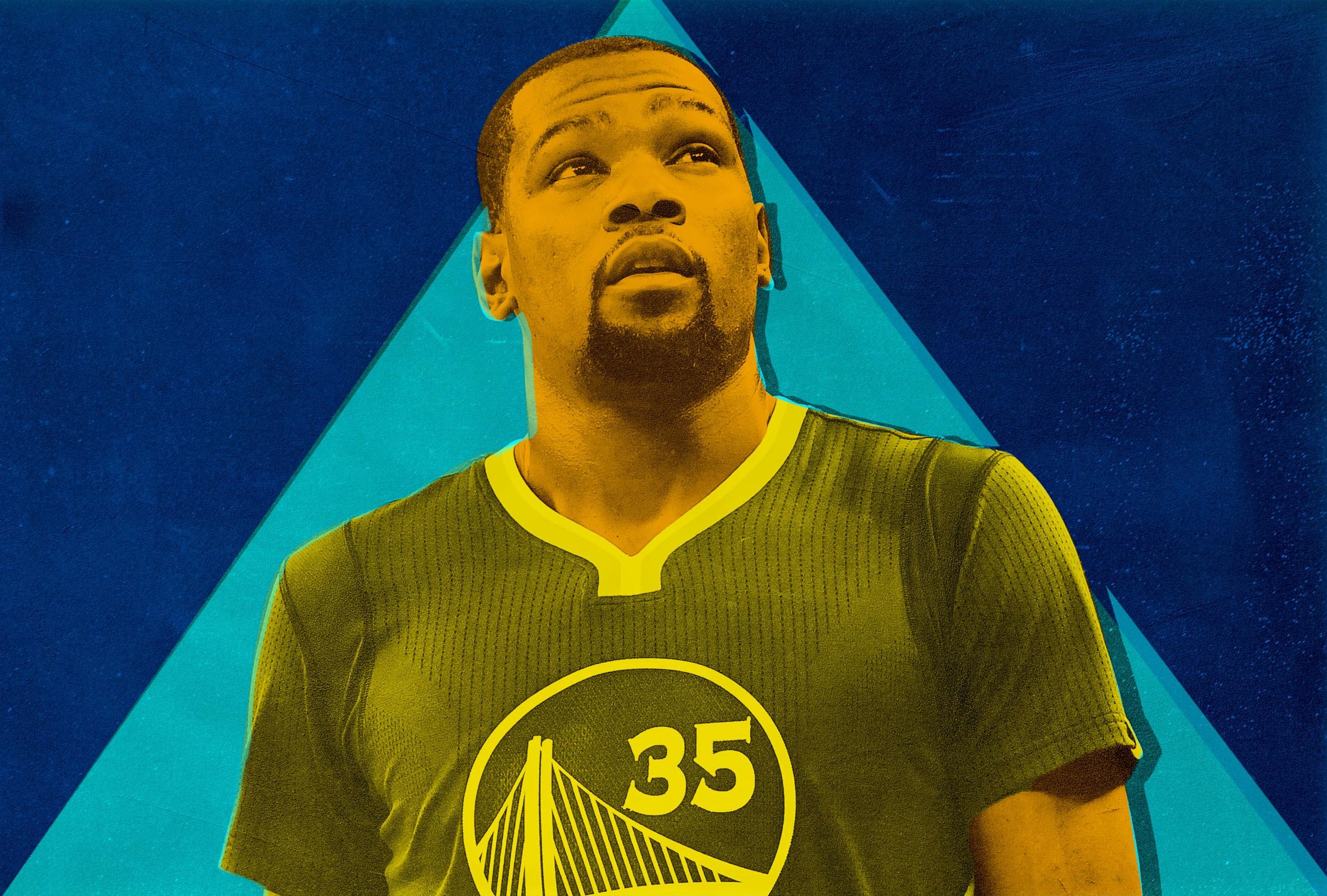
Kevin Durant was the most dominant scorer on the planet by the time he was 22. He averaged 30.6 points per game on 54.8 percent shooting in the 2012 NBA Finals, but the Thunder still lost to LeBron’s Heat in five games. In the years since, Durant has grown by leaps and bounds as a player, but he’s only now returning to the NBA’s biggest stage. LeBron never left. He is the player the rest of the league measures themselves against, and Durant has spent his entire career in his shadow. He can change that in these Finals. In terms of legacy, no one else on either team has more on the line. Durant is the only significant player without a ring, and he’s 5–18 in his career against LeBron. LeBron led both teams in points, rebounds, assists, steals, and blocks in last season’s Finals. If Durant just plays him to a draw, the Warriors will win.
Durant played the best basketball of his career in his first season in Golden State. While he is averaging his fewest points per game since his rookie season, playing on a team with more balanced offensive production has allowed him to diversify his game. The Thunder tried to put as many defensive-minded role players as possible around Durant and Russell Westbrook, counting on their dynamic duo to carry the offense through the sheer weight of their isolation brilliance. The Warriors offer a more democratic approach, a roster full of skilled players who moved the ball and looked for the best shot on every possession, rather than standing in the corner and staying out of the way of their stars. Durant averaged career highs in field goal percentage (53.7 percent), rebounds (8.3), assist-to-turnover ratio (2.17-to-1), and blocks (1.6) this season. He is playing more like LeBron than ever before.
Durant’s versatility has been on full display in the playoffs. He has had games where he led the Warriors in points, rebounds, assists, and blocks over the past few weeks, adjusting his game to give his team whatever it needed to win. Even on nights when his shot isn’t falling as consistently, Durant can still find ways to impact the game, whether it’s guarding the opposing team’s best player, cleaning the defensive glass and pushing the ball up the floor, or demanding a double-team in the post and creating an open shot for one of his teammates. It’s a far cry from the player he was as a rookie, or even in his first trip to the Finals, when the Thunder ran their fourth-quarter offense through Westbrook and James Harden and didn’t ask Durant to do all that much on defense. Harden and Thabo Sefolosha guarded LeBron in 2012, not Durant.
If Cavs vs. Warriors is the NBA’s version of the Fast & Furious franchise, then Durant is the Rock, a newcomer who could wind up overshadowing the original cast and using the franchise to propel his own star to the next level. His presence changes everything about the matchup between the two teams. By the end of last year’s Finals, Cleveland ignored Harrison Barnes completely, using his defender to protect the paint and daring him to beat it from the perimeter. Instead of helping off Durant, the Cavs are going to have to send help his way, freeing up opportunities for everyone else on Golden State’s roster. On the other side of the floor, Durant’s length and athleticism allows the Warriors to stay big when they go small, giving them a second rebounder and rim protector next to Draymond Green when he’s playing center.
Adding Durant effectively neutralizes the key advantage the Cavs had in the 2016 Finals. LeBron shut down Draymond for most of that series, but he can’t guard him and Durant at the same time. Not only could LeBron use his superior size and athleticism to contain Green off the dribble, he could switch any screen Green set for Steph Curry, allowing everyone else to stay at home and neutralizing the Green-and-Curry pick-and-roll. If LeBron is guarding Green, though, that leaves J.R. Smith, Richard Jefferson, or Iman Shumpert on Durant, none of whom has much of a prayer of preventing Durant from scoring at will. There’s a domino effect when it comes to matchups: The only way for LeBron, Tristan Thompson, and Kevin Love to all be on the floor against the Lineup of Death is for one of them to guard either Durant, Curry, or Klay Thompson.
The Cavs will try to bait Durant into playing one-on-one when he has a weaker defender on him, much like they did at the end of their win over the Warriors on Christmas Day. Durant went 2-for-9 in the fourth quarter, turning Curry, Green, and Thompson into spectators as he fired up shots off the dribble. Durant doesn’t need to hold the ball to get his own offense: He can be just as deadly setting screens and popping out to the 3-point line, curling off them and dragging the defense out of the paint, and crashing the offensive glass. When he moved the ball in Oklahoma City, there was no guarantee he would get it back. In Golden State, the ball finds the open man, and Durant has never spent more time being open. He averaged 60.3 percent shooting in the Western Conference finals, the most efficient playoff series of his career.
Whenever the Warriors have needed to win in the past few playoffs, they have gone smaller, taking their traditional big men off the floor and trying to beat teams with speed, shooting, and athleticism. That strategy put a huge burden on Green’s shoulders, and he seemed to crack under the weight in last year’s playoffs. When Draymond was off the floor, Golden State didn’t have anyone who could replicate his impact on either side of the ball. Cleveland won Game 7 of last year’s Finals during the time Festus Ezeli (minus-9 in 11 minutes) and Anderson Varejão (minus-9 in eight minutes) were in. Ezeli and Varejão are gone, but Zaza Pachulia, David West, and JaVale McGee all have holes in their games the Cavs can exploit. The difference is the Warriors can use Durant as a backup center this time around.
Durant is listed at 6-foot-9 and 240 pounds, but he was measured at 6-foot-10 in shoes at the NBA draft combine in 2007 and he has gotten taller since. He’s a 7-footer who can do everything on the court at an extremely high level. There has never been a player in NBA history with his combination of size, athleticism, and shooting ability. He’s the endpoint in the evolution of the game: a big man who can shoot, handle, and pass like a guard and a guard who can rebound, defend, and block shots like a big man. LeBron has steadily turned himself into a point center over the course of his career, but not even he can match Durant’s offensive versatility. Opposing defenses will live with LeBron beating them from the perimeter. That’s not an option with Durant, who is one of the best shooters in the league, regardless of size.
He has been able to score at will since his days at Texas, where he became the first freshman in NCAA history to win the Wooden Award. Durant’s problem over the course of his first nine seasons in the NBA was that the Thunder inevitably would run into a team that played more efficiently because they did a better job of moving the ball. No one can win a title just by scoring a lot of points. The greatest players dominate every facet of the game, and Durant has spent the past decade diversifying his skill set to the point where he could be the best player on a championship team. Durant had improved since his first playoff meeting with LeBron in 2012, but his team had gotten worse. He might have eventually won a title had he stayed in Oklahoma City, but he has a chance to be part of something really special in Golden State.
When he signed with the Warriors, Durant went from being on one of the best teams in the NBA to being on one of the best teams in NBA history. Golden State is 12–0 in the postseason, and it has the highest point differential (plus-16.0) of any team that has ever headed into the Finals. The Warriors are built for the long haul, too. Durant is 28, half a year younger than Curry; Green and Thompson are 27. While it will be extremely expensive to keep all four together, there’s much more money in the Bay Area than Oklahoma City, which broke up a potential dynasty before it even got started because of luxury-tax concerns. The Warriors have also shown the ability to find talented players later in the draft and maximize the abilities of veterans they pick up off the scrap heap. This might not be the best Golden State team that Durant plays on.
Durant’s age is significant in other ways; at 28, he is one year older than LeBron and Michael Jordan were when they won their first championship. Durant has a better supporting cast than either player had then. People have been comparing LeBron to Jordan since the day he came into the league out of high school, but his career trajectory could end up looking more like Magic Johnson. Jordan won his first title by beating Magic and the Lakers in 1991, and the Bulls never looked back from there. LeBron could serve as the gatekeeper to a dynasty just as Magic did before him. If Durant continues to grow as an all-around player, it’s going to be hard for anyone to catch the Warriors. He has done everything that can be done in the NBA except win a championship. There’s only one thing standing in his path to all-time greatness. If Kevin Durant’s life is a video game, LeBron James is the final boss.

